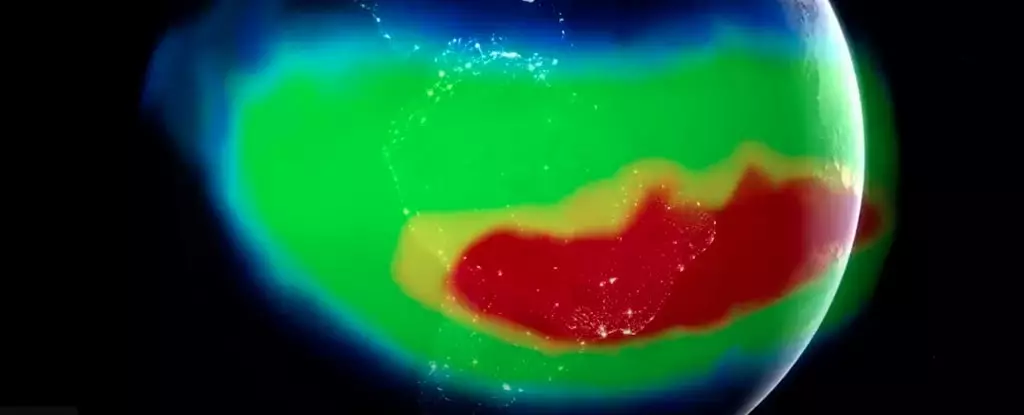Nestled between South America and southwest Africa lies a perplexing anomaly that piques the interest of scientists and researchers alike. Dubbed the South Atlantic Anomaly (SAA), this peculiar region is characterized by a weakened magnetic field, akin to a dent in the Earth’s protective magnetic shield. Unlike any other phenomenon observed on our planet, the SAA serves as a focal point for scientific study, raising questions about the intricate workings of Earth’s magnetism. Although this anomaly poses minimal risk to life on Earth’s surface, its implications extend far beyond, especially for orbiting satellites and spacecraft that traverse its path.
The world may not feel the tremors of the SAA in their daily lives, but the complexity of understanding it goes beyond mere curiosity. The South Atlantic Anomaly’s magnetic field strength offers a unique platform for scientists to investigate phenomena that hold significant implications for our understanding of Earth’s geophysical properties. As the space agency tasked with delving deep into these enigmas, NASA has been actively observing the SAA, recognizing both its risks and opportunities for scientific breakthroughs.
The Technological Threat
One of the most pressing concerns regarding the South Atlantic Anomaly is its potential impact on technology and space exploration. The weakened magnetic field in this area exposes satellites and the International Space Station to an influx of charged particles unleashed by the Sun. Such exposure is particularly concerning for NASA’s various missions, as the anomaly can lead to disruptions in electronic systems. Engineers must routinely implement safety protocols, shutting down non-essential spacecraft systems as they approach this magnetic gauntlet to avoid the risk of malfunctions.
These glitches could range from temporary data loss to long-lasting damage of crucial components of the spacecraft, illustrating the delicate balance between human ingenuity in technology and the unpredictable nature of Earth’s magnetic behavior. The apparent randomness of these high-energy proton events adds an unpredictability that could jeopardize scientific missions. It raises an important point: as humanity pushes the limits in space exploration, understanding phenomena like the SAA becomes even more critical to mission success.
Insights from Geophysical Studies
To comprehend the intricacies of the South Atlantic Anomaly, geophysicists have been avidly pursuing insights that reveal its origins and nature. The magnetic field’s existence is attributed to complex interactions occurring deep within the Earth, specifically, the movement of molten iron circulating within its outer core, thousands of kilometers below the surface. This phenomenon provides a dynamic backdrop in which electric currents emerge, giving rise to an ever-evolving magnetic field that shapes our planet.
However, a significant source of disturbance is believed to stem from a dense reservoir of rock known as the African Large Low Shear Velocity Province, located nearly 2,900 kilometers beneath the African continent. This peculiar geological feature influences the behavior of Earth’s magnetic field, likening it to a complex set of layered currents that sometimes misalign, leading to the peculiar behavior observed in the SAA. As researchers like Terry Sabaka from NASA’s Goddard Space Flight Center recognize, understanding these intricate mechanisms is vital to decoding the SAA’s mysteries.
The Anomaly’s Evolution
What truly captivates researchers is not merely the existence of the SAA but its ongoing transformation and evolution. Recent studies, including work led by heliophysicist Ashley Greeley, have revealed compelling dynamism within this enigmatic region. Surprisingly, the anomaly is not static; observations indicate that it is gradually drifting, corroborated by data from CubeSats deployed for this very purpose. What’s more, the SAA seems to be undergoing a division, splitting into two separate centers of weakened magnetic intensity. This evolving structure only adds layers to the mystery: raising the question of what implications this will hold for Earth’s magnetic field in the long term.
The South Atlantic Anomaly is suspected to be a recurring phenomenon, having existed in varying forms for potentially millions of years. Recent research suggests that the SAA’s characteristics are not transient but perhaps a staple of Earth’s geological history. As scientists digest this information, they are left pondering whether it signifies a larger cycle of magnetic transformations that could hint at future shifts in Earth’s magnetism.
A Call for Continued Investigation
As humanity stares into the vastness of space, the South Atlantic Anomaly stands as a reminder of our planet’s complexities yet to be fully understood. The conundrum that lies within this magnetic quirk holds tantalizing possibilities for scientific inquiry. As NASA continues its vigilant observations and research surrounding the anomaly, we are reminded of the delicate interplay between technology, nature, and the wonders that persist just beyond our reach. As researchers rally to uncover its secrets, one thing remains clear: our quest for knowledge is far from over, and the SAA presents a compelling case for understanding the rhythmic dance of Earth’s magnetic forces.


Leave a Reply